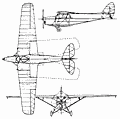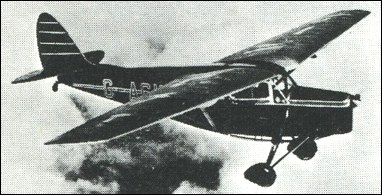|
| Introduced in 1933 as a successor to the
Puss Moth, the de Havilland D.H.85
Leopard Moth bore a superficial resemblance
to the earlier aircraft but incorporated
a number of major changes,
not the least of which was revised fuselage
construction. The steel-tube structure
of the Puss Moth was replaced by
the spruce and plywood box which was
becoming a de Havilland standard, providing
accommodation for the pilot, and
for two passengers who were seated side-by-side in the rear of the cabin. New
tapered and foldable wings with swept
leading edges were fitted, and the main
landing gear upper shock-absorber
attachment points were relocated. The
prototype made its first flight on 27 May
1933 at Stag Lane, and just two weeks
later won that year's King's Cup Race at
Hatfield; two similar aircraft finished
third and sixth. This auspicious start ensured
commercial success, and three
years' production, initially at Stag Lane
and then at Hatfield, totalled 132
examples.
 | A three-view drawing (800 x 794) |
| MODEL | D.H.85 |
| ENGINE | 1 x de Havilland Gipsy Major inline piston engine, 97kW |
| WEIGHTS |
| Take-off weight | 1009 kg | 2224 lb |
| Empty weight | 637 kg | 1404 lb |
| DIMENSIONS |
| Wingspan | 11.43 m | 38 ft 6 in |
| Length | 7.47 m | 25 ft 6 in |
| Height | 2.67 m | 9 ft 9 in |
| Wing area | 19.14 m2 | 206.02 sq ft |
| PERFORMANCE |
| Max. speed | 220 km/h | 137 mph |
| Cruise speed | 192 km/h | 119 mph |
| Ceiling | 6555 m | 21500 ft |
| Range | 1151 km | 715 miles |
| H. Kubota, e-mail, 05.12.2009 11:54 Is this a first monoplane with a single engine as the D.H. reply |
|
Do you have any comments?
|
| 
COMPANY
PROFILE
All the World's Rotorcraft
|







 H. Kubota
H. Kubota
comment6,
reply